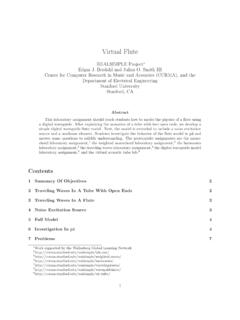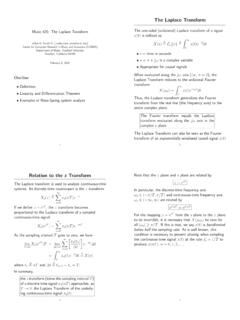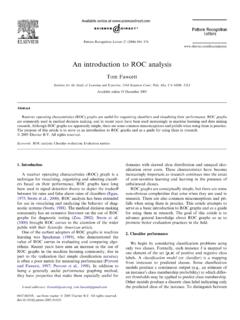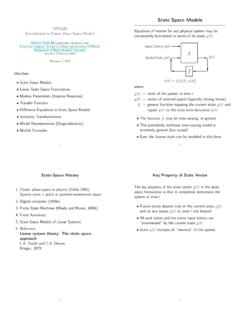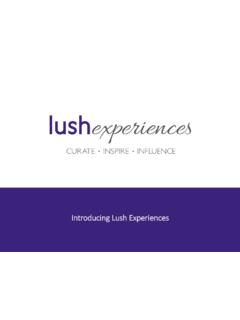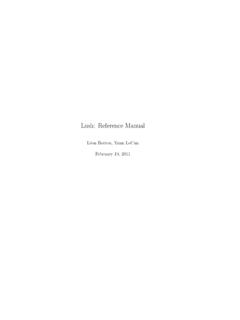Transcription of LUSH: An Organic Eco+Music System - CCRMA
1 LUSH: An Organic Eco+Music System Hongchan Choi Musical Art and Technology Laboratory (MARTE) Dongguk University Jung-gu, Pil-dong 3-26, Seoul, Korea Ge Wang Center for Computer Research in Music and Acoustics ( CCRMA ) Stanford University 660 Lomita Dr. Stanford, CA 94305 ABSTRACT We propose an environment that allows users to create music by leveraging playful visualization and Organic interaction. Our attempt to improve ideas drawn from traditional sequencer paradigm has been made in terms of extemporizing music and associating with visualization in real-time. In order to offer different user experience and musical possibility, this System incorporates many techniques, including; flocking simulation, nondeterministic finite automata (NFA), score file analysis, vector calculation, OpenGL animation, and networking.
2 We transform a sequencer into an audiovisual platform for composition and performance, which is furnished with artistry and ease of use. Thus we believe that it is suitable for not only artists such as algorithmic composers or audiovisual performers, but also anyone who wants to play music and imagery in a different way. Keywords Algorithmic composition, behavior simulation, automata, music visualization, music sequencer, musical interface, audiovisual frameworks. 1. MOTIVATION The foremost motivation of this System is to defy the stereotypes of conventional music sequencers and suggests an alternative that provides more Organic interaction and combines visualization and probabilistic elements aesthetically.
3 We achieved the investigation by renovating the visual facet of the sequencer and adding features such as algorithmic music generation and networking. Since the music sequencer was invented around 1950, it has played a central role in music production. From the analog sequencer equipped with dozens of relay circuits, switches and knobs to the software sequencer for Atari personal computers, musicians and engineers have constantly pursued to enhance and complement its shape and feature. The advent of computer-based sequencers at early 1980s had largely contributed to the productivity and efficiency in music creation by assisting musicians to manipulate musical events in a visual way.
4 Thanks to the introduction of graphic user interface (GUI) and ever-increasing computing power, the capability of the traditional sequencer was expanded by integration of audio editing, recording and even sound synthesis. Although numerous variations of music sequencers have emerged throughout the computer music history, most of them have two elements in common; a System -wide playhead and the visual representation of discrete notes to be played. They are useful and informative to the user in view of providing the flexibility of non-linear editing. These visual cues improve the overall workflow in general, however, they become crucial restraints particularly when creating a generative piece or improvisation.
5 We believe music creation process continues to Permission to make digital or hard copies of all or part of this work for personal or classroom use is granted without fee provided that copies are not made or distributed for profit or commercial advantage and that copies bear this notice and the full citation on the first page. To copy otherwise, or republish, to post on servers or to redistribute to lists, requires prior specific permission and/or a fee. NIME2010, 15-18th June 2010, Sydney, Australia Copyright remains with the author(s). Figure 1. The sea of Lush. A colorful blob called boid is considered to be identical to a musical note. (left) Movable playheads can be exists simultaneously to play various musical boids with sonic properties.
6 (right) Proceedings of the 2010 Conference on New Interfaces for Musical Expression (NIME 2010), Sydney, Australia112change in order to be more spontaneous as well as interactive; this idea will shift the traditional paradigm of the music sequencer ultimately. Lush, as Eco+Music System we claim, embodies the following ideas: Highly visualized environment tailored for interaction and improvisation, proposing new musical entities of movable playheads and notes like living organism. Exploration of countless possibilities by generating music sequence from nondeterministic finite automata (NFA), built by analyzing a score data. ( a standard MIDI file) This also offers chances to reuse and visualize a vast collection of score files.
7 Supporting OSC(OpenSound Control) allows the System to function as visual front-end or control interface for OSC-compatible music software as well as to collaborate with other Lush System by communicating generated data over the network [10]. In sum, we incorporate several features such as interaction, visualization, algorithmic composition and networking into one System bearing aesthetic and usability in mind. 2. EXISTING RELATED WORKS A variety of audiovisual systems that influenced and inspired us are derived mainly from three areas: hybrid music sequencer, such as Music Insects and Electro Plankton (figure 2) [1] created by Toshio Iwai, graphical/collaborative music interfaces such as Audicle (figure 2) [2], and algorithmic music generation.
8 Iwai Toshio s Music Insects and Electro Plankton, the most influential examples to our System , realize a series of novel concepts in software by transforming the visual limitation that traditional music sequencers have. Various graphical/collaborative interfaces in Audicle also inspired our work, especially in terms of music generation and network collaboration. The ideas of electronic chamber music , pioneered by the Princeton Laptop Orchestra (PLOrk) and Stanford Laptop Orchestra (SLOrk), introduced a new form of musical environment based on innovative visual representation and collaboration. In addition, Rob Hamilton s Q3 OSC is also similar with our System in several aspects; it is derived from 3D gaming platform supports animated visual, dynamic interaction and network gaming [3].
9 Making music with stochastic algorithm, which is the essential part of our System , has a long-standing history. It is partly due to the accessibility of stochastic algorithms that they have become so extensively employed for compositional purpose. The CAMUS 3D System is an example of musical application leveraging stochastic quality of cellular automata [8] and it can be labeled as the first standalone software for algorithmic composition. Golan Levin has pioneered the multi-modality for audiovisual System in his remarkable projects. Levin s Painterly Interfaces [4] have introduced a new sense of audiovisual aesthetic focused on Organic and natural properties.
10 Scrapple, the one of his sound installation, also suggests how the music sequencer can be evolved in collaborative and tangible way [5]. His insight to simplicity and Organic senses has largely motivated and informed our exploration. Additionally, tangible music sequencers such as Tenorion created by Toshio [6] and Siftable created by David Merrill [7] also introduced the new way of music making. These works are not related to Lush directly, however, their strong implication to new approaches for music making can be considered our next step. 3. USER EXPERIENCE The user can use this System for either casual or creative purpose. First of all, Lush is designed to provide multi-colored animated visualization of the source score file so that one can simply enjoy its motion graphics.
